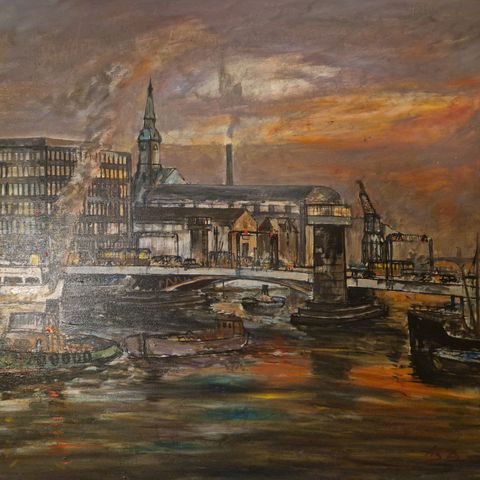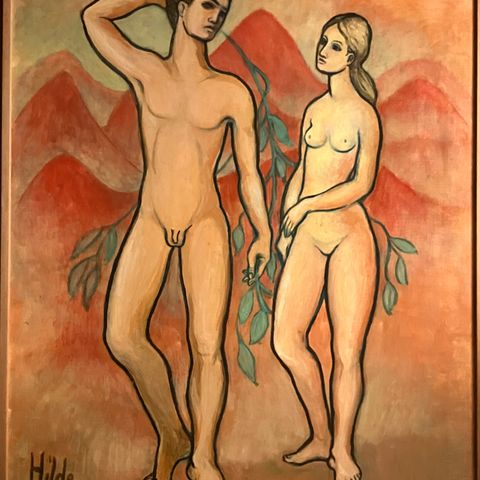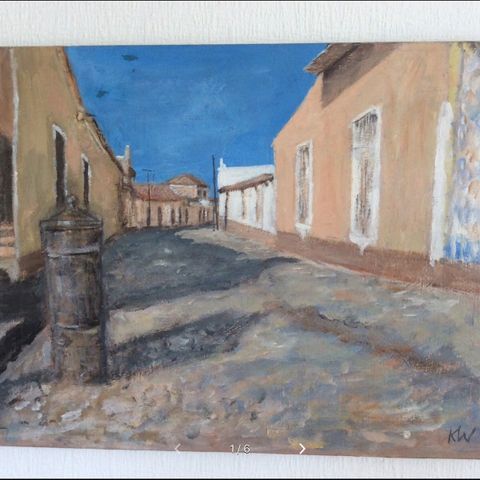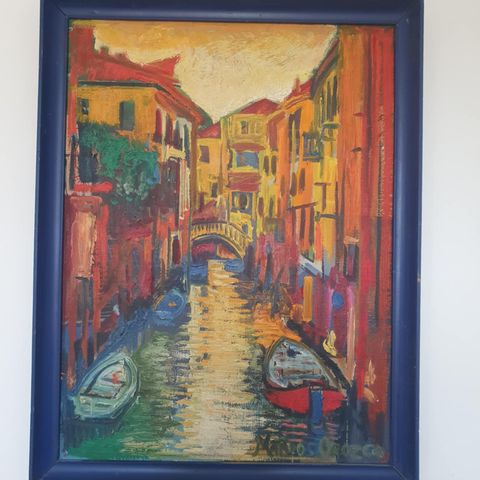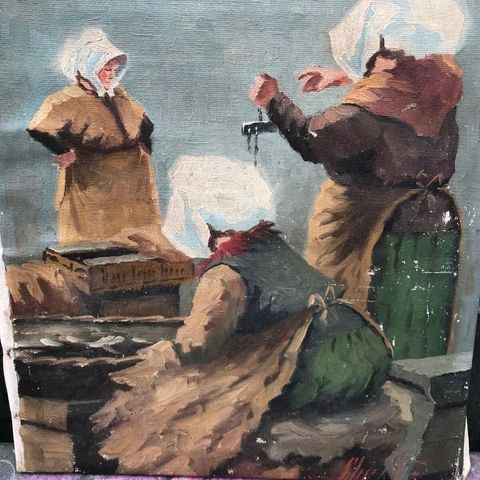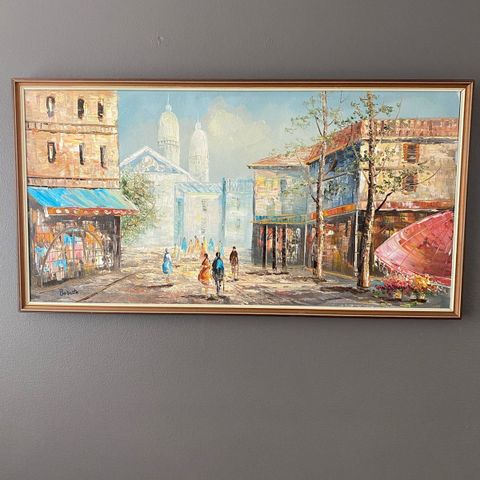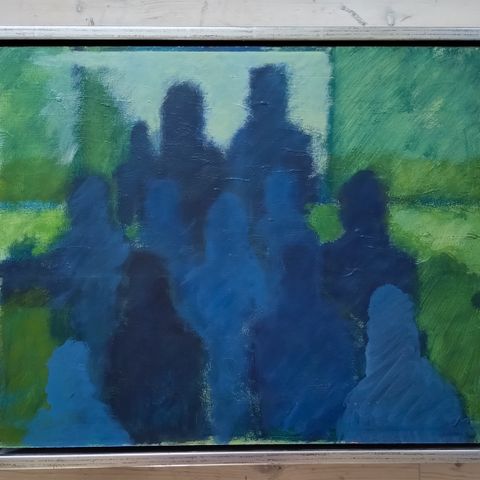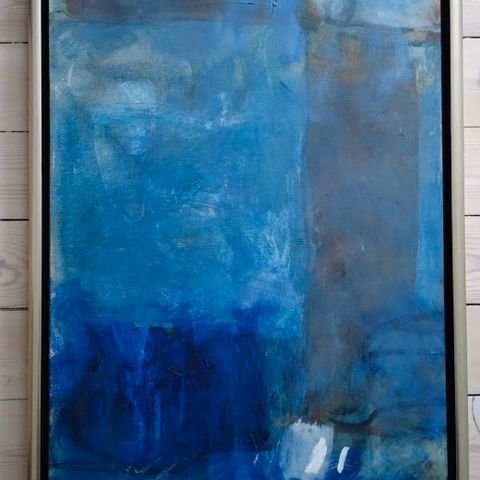Billedgalleri
Smukt maleri af Christianshavn malet af Lis Bjergsted
Varebeskrivelse
Stand: Brugt - men i god stand
Jeg har et flot maleri af Christianshavn, som min mor har arvet fra min morfar. Det er malet tilbage i 1960'erne af den kvindelige kunstner Lis Bjergsted. Det har en fed retro stil med en smuk guldramme i massivt træ.
Maleriet måler 93 cm x 93 cm inkl. rammen.
Lidt baggrundsviden om Lis Bjergsted:
Lis Bjergsted malede mange motiver fra København, men man ved ikke så meget om hende. De sidste år af sit liv boede hun i England
Lis Bjergsted blev født som Lis Hansen i København, datter af en værtshusejer - Var på kostskole på Amager under Besættelsen, og skulle have været ret syg med bl.a. lungebetændelse pga manglende varme på skolen.
Uddannet på teknisk skole og private malerskoler. Studeret i Paris, hun var af fransk afstamning, hvor hun fik undervisning på kendte malerskoler. Hun studerede ivrigt de franske klassiske malere, af hvem hun navnlig følte sig tiltrukket af impressionisterne, hvilket hendes billeder også bærer præg af. Hendes udstillinger i både Paris og København fik fin modtagelse; kendte franske og skandinaviske samlere indkøbte flere af hendes værker. Det var navnlig som arkitekturmaler, hun vandt stor anerkendelse, og hendes bymotiver med deres farverigdom virker lyse og lette og vidner om virkelig indlevelsesevne i det motiv, hun havde under behandling i billedet.
The following information is from Willy Bjergsted Jensen, youngest son of the artist.
Lis Bjergsted also known as Paula French (9 October 1929 - 27 October 2011) was a Danish realist painter mostly known for her oil on canvas, but she was equally proficient as a watercolorist. She was fascinated by City atmosphere, architecture and made cityscapes the subject of her work. Her cityscapes convey the weather's elements, city atmosphere and architecture in a soft realistic style with a distinct style and tonal palette.
Early life
Lis Bjergsted, born Lis Hansen in Copenhagen, Denmark, was a single child of a pub - restaurant owner. She attended boarding school in Amager during Second World War where she was plagued by illness and reoccurring pneumonia, presumably, largely due to lack of heating in the school and dormitory.
Interest in art
As a child she had asked her mum for a photographic camera and got hugely disappointed when receiving a toy camera; her interest in art and motif had gone unnoticed. Post schooling she took a daytime job with a high court solicitor and an evening job as a piano player, it was in her job as a piano player she met and later on married Danish musician and artist Eli Ernst Bjergsted Jensen.
Hardship
Due to economical/cultural changes in the mid 1950's, the need for musician's declined and her husband had to find other means of earning a living, which included working as a designer of jewelry, lamps and as a painter of oil on canvas, which he sold for pubs and markets. Although she had a daytime job, her income was insufficient to pay all the bills.
Having paint and blank canvases in the home, she was eager to have a go at painting, and her husband soon discovered that her paintings sold extremely easy. The couple decided that she should devote her efforts to painting and her husband would look after children and manage her career.
Breakthrough
In the late 1950's she got a contract with a gallery and as a result of talks with the gallery the couple decided that her husband should concentrate on developing a more distinct signature; her husband worked tirelessly on developing a brush and stroke technique, the signature color also changed from black to a shade of brown.
Success
The contract with the gallery increased the revenue per picture, allowing her more freedom to develop her style and technique. On 14 September 1963, US Vice President Lyndon B Johnson purchased two of her oil on canvas pictures, which resulted in export to the US and a significant price increase, which raised the house hold finances well above the poverty line. This event also accelerated her popularity to the point that the art dealer would collect paintings, frame them and sometimes sell them before the paint had dried (NOTE: Extreme caution should be exercised if you need to separate a Lis Bjergsted painting from its frame).
In the early 1980's her youngest son had to go to London on business. Being unattached and knowing of his mum's love for architecture and city life, he took her along, which resulted in a number of London subject oil on canvas paintings.
Adversity
In 1982's her husband took sick and developed an adverse reaction to turpentine fumes, which meant she had to scale down her output in order to reduce the amount of turpentine fumes in the home. So she also started experimenting with watercolors. By 1983 her husband's adverse reaction to turpentine fumes had become so severe she had stopped oil on painting altogether. Her husband died in 1984.
New Beginning
The youngest son had immigrated to England, and upon hearing that his dad had died, he invited his mother to come and live with him, an offer she accepted.
Upon arriving in the United Kingdom she changed her artist name from Lis Bjergsted to Paula French, her mother's maiden name, on the grounds that Bjergsted was too difficult for the English tongue.
Armed with photographs of previous work she ventured out to talk to galleries, the first gallery she visited immediately ordered two commissions of 19th century London scenes. Before finishing the commissions she decided that she didn't want to do that again. So upon presenting the commissions to the gallery and learning the gallery owner wanted to order more, she declined, having made up her mind that she was more interested in developing a new style and doing something more contemporary than 19 century.
Easy life
Living with her son, she was no longer pressured by financial needs because her son had pledged his full support and provided her with pocket money on regular basis. Having found a new freedom, she went to work on both her oil on canvas and watercolor techniques and over the years produced a number of collections, which she sold through London galleries. She also devoted significant effort to studying old English masters and attended many exhibitions of both traditional and contemporary work.
Personality
She was an astute diplomat with a strong sense of fairness, solidarity and modesty, and she refused to discuss herself or her art out of fear of sounding brash or provoking jealousy. She was serious about her art and the art of others, and when asked would always offer a diplomatic opinion. Her husband always signed her work, and until his death, she had never signed a canvas or a watercolor knowing that after all, it was her husband's canvas and oil paint which got her started. Having him signing every piece of work had given him an important function and input into every picture.
Her work ethic throughout her life was exemplary, she worked 12 -14 hours every day 7 days per week and rarely would she take time out for leisure.
Brugerprofil

Du skal være logget ind for at se brugerprofiler og sende beskeder.
Log indAnnoncens metadata
Sidst redigeret: 26.4.2025 kl. 13:50 ・ Annonce-ID: 9410798





